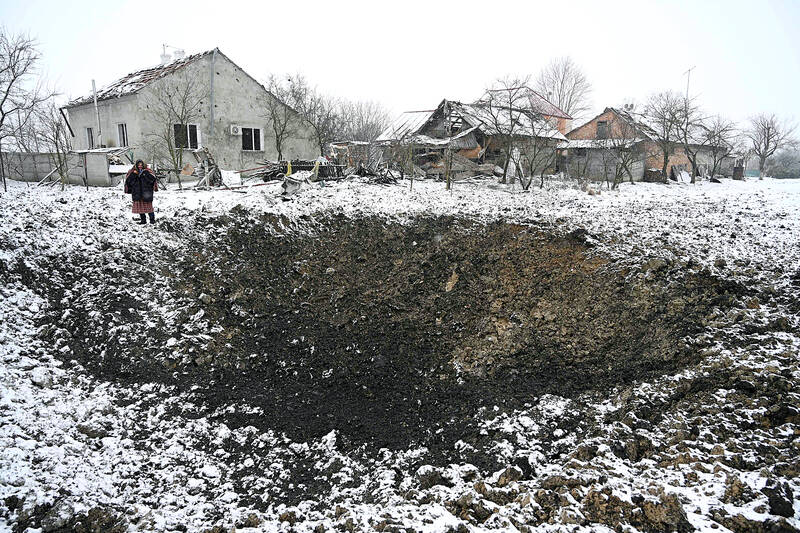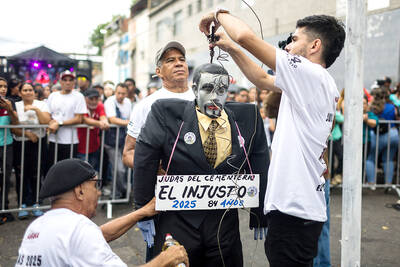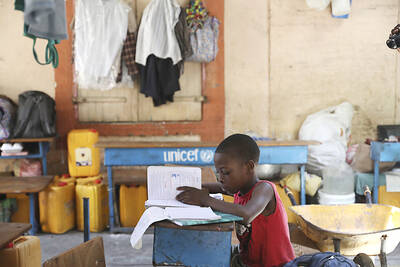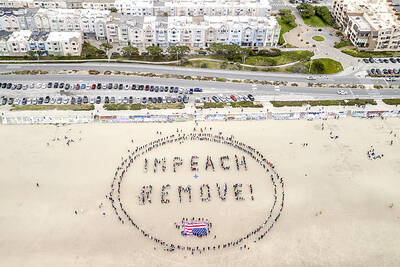Russia on Wednesday launched a wave of missiles and drones at Ukrainian energy facilities, intensifying a months-long bombing campaign at a precarious moment of the war for Ukraine.
The barrage came a day after Kyiv said it had carried out its largest aerial attack of the war on Russian army factories and energy hubs hundreds of kilometers from the front line.
The Ukrainian air force said Russia launched 43 cruise and ballistic missiles as well as 74 attack drones in the barrage, which targeted sites mainly in western Ukraine.

Photo: AFP
Oleksandra Komuna, an elderly resident of the western Ukrainian village of Sknyliv, was at home during the attack when lamps and plaster began falling.
“All the doors and windows were blown out, everything was blown out. The car was damaged, and the roof was damaged. There were cracks everywhere,” she said. “It’s such a disaster.”
Ukrainian President Volodymyr Zelenskiy was quick to condemn the strikes and called for more robust security assistance from allies abroad.
“Another massive Russian attack. It is the middle of winter, and the target for the Russians remains the same: our energy sector,” he wrote on social media.
The Russian Ministry of Defense confirmed in a daily briefing that its forces had carried out “high precision” strikes on energy facilities that “support the Ukrainian military-industrial complex.”
It also repeated the claim that all the designated targets had been struck.
However, the Ukrainian air force said that it had shot down 30 of the missiles and 47 drones, while Ukrainian Prime Minister Denys Shmygal said the Russian attack had “failed”.
Hours after the barrage, Zelenskiy called on the West to use about US$250 billion of unallocated frozen Russian assets to buy Kyiv weapons. He was speaking at a press conference in Warsaw with Polish President Andrzej Duda.
“Ukraine will take this money, allocate a large amount for domestic production and for the import of exactly those types of weapons that Ukraine does not have,” he said.
The EU last week paid out to Kyiv the first 3 billion euros (US$3.1 billion) of a loan backed by the interest earned on frozen Russian assets.
The US Department of State on Wednesday announced new sanctions on “more than 150 individuals and entities involved in Russia’s defense industry and supporting its military-industrial base.”
Meanwhile, US president-elect Donald Trump’s nominee for secretary of state, Marco Rubio, said that the new administration would seek “bold diplomacy” to end the war.
“There will have to be concessions made by the Russian Federation, but also by the Ukrainians,” he said.
Moscow has pursued a months-long bombing campaign against Ukrainian energy infrastructure, claiming the attacks targeted facilities that aid Kyiv’s military.
The Russian military had accused Kyiv of using US and UK-supplied missiles for one of the strikes the previous day and promised it would “not go unanswered.”
On Wednesday evening in Russia’s Voronezh Oblast bordering Ukraine several drones “sparked a fire at an oil depot,” Voronezh Governor Alexander Gusev said on Telegram, as videos posted by witnesses showed a substantial blaze.
Kyiv and Moscow’s escalating drone and missile attacks come at a difficult moment for Ukraine across the sprawling front line.
At several key points in the northern Kharkiv and eastern Donetsk regions, Russian forces have been able to steadily advance by exploiting their advantages in personnel and resources.
Building on those gains, the Russian defense ministry on Wednesday said that its forces had captured the village of Ukrainka in the industrial Donetsk region that the Kremlin claims is part of Russia.
Despite the war having ground on for nearly three years, there are still some areas of cooperation between Moscow and Kyiv, which announced on Wednesday that they had exchanged 25 prisoners of war each.

POLITICAL PRISONERS VS DEPORTEES: Venezuela’s prosecutor’s office slammed the call by El Salvador’s leader, accusing him of crimes against humanity Salvadoran President Nayib Bukele on Sunday proposed carrying out a prisoner swap with Venezuela, suggesting he would exchange Venezuelan deportees from the US his government has kept imprisoned for what he called “political prisoners” in Venezuela. In a post on X, directed at Venezuelan President Nicolas Maduro, Bukele listed off a number of family members of high-level opposition figures in Venezuela, journalists and activists detained during the South American government’s electoral crackdown last year. “The only reason they are imprisoned is for having opposed you and your electoral fraud,” he wrote to Maduro. “However, I want to propose a humanitarian agreement that

Young women standing idly around a park in Tokyo’s west suggest that a giant statue of Godzilla is not the only attraction for a record number of foreign tourists. Their faces lit by the cold glow of their phones, the women lining Okubo Park are evidence that sex tourism has developed as a dark flipside to the bustling Kabukicho nightlife district. Increasing numbers of foreign men are flocking to the area after seeing videos on social media. One of the women said that the area near Kabukicho, where Godzilla rumbles and belches smoke atop a cinema, has become a “real

‘POINT OF NO RETURN’: The Caribbean nation needs increased international funding and support for a multinational force to help police tackle expanding gang violence The top UN official in Haiti on Monday sounded an alarm to the UN Security Council that escalating gang violence is liable to lead the Caribbean nation to “a point of no return.” Special Representative of the UN Secretary-General for Haiti Maria Isabel Salvador said that “Haiti could face total chaos” without increased funding and support for the operation of the Kenya-led multinational force helping Haiti’s police to tackle the gangs’ expanding violence into areas beyond the capital, Port-Au-Prince. Most recently, gangs seized the city of Mirebalais in central Haiti, and during the attack more than 500 prisoners were freed, she said.

DEMONSTRATIONS: A protester said although she would normally sit back and wait for the next election, she cannot do it this time, adding that ‘we’ve lost too much already’ Thousands of protesters rallied on Saturday in New York, Washington and other cities across the US for a second major round of demonstrations against US President Donald Trump and his hard-line policies. In New York, people gathered outside the city’s main library carrying signs targeting the US president with slogans such as: “No Kings in America” and “Resist Tyranny.” Many took aim at Trump’s deportations of undocumented migrants, chanting: “No ICE [Immigration and Customs Enforcement], no fear, immigrants are welcome here.” In Washington, protesters voiced concern that Trump was threatening long-respected constitutional norms, including the right to due process. The